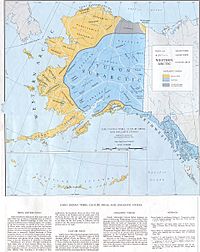Denaʼina facts for kids
The Denaʼina (pronounced dee-NYE-nuh), also known in the past as Tanaina, are a group of Native Alaskan people. They are part of the larger Athabaskan family. The Denaʼina were the first people to live in south-central Alaska. Their homeland stretches from Seldovia in the south to Chickaloon in the northeast, and from Talkeetna in the north to Lime Village in the northwest. This area, which they call Denaʼina Ełnena, is huge, covering over 41,000 square miles!
The Denaʼina arrived in this area about 1,000 to 1,500 years ago. They are special because they were the only Athabaskan group in Alaska to live right on the coast, near the ocean. They traditionally lived by hunting and gathering, and their society followed a matrilineal system, meaning family lines and property were passed down through the mother's side. The famous Iditarod Trail actually follows old paths used by the Denaʼina and other Native Alaskan groups.
Their neighbors include other Athabaskan peoples like the Deg Hitʼan and Ahtna, as well as Yupik peoples who live to their west and southwest.

|
|
| Total population | |
|---|---|
| 1,000 | |
| Regions with significant populations | |
| United States (Alaska) | |
| Languages | |
| English, Denaʼina, Russian | |
| Religion | |
| Orthodox Christianity, Animism | |
| Related ethnic groups | |
| Ahtna, Deg Hitʼan, other northern Athabaskan peoples |
Contents
What "Denaʼina" Means
The name "Denaʼina" has a special meaning. It comes from two parts of their language: dena, which means "person," and ina, which makes it plural. So, "Denaʼina" means "the people." It's similar to the name "Diné" used by the Navajo people.
The Denaʼina name for Cook Inlet, a large body of water in Alaska, is Tikahtnu. This means "Big Water River" or "Ocean River." They also call it Nuti, meaning "Saltwater."
Denaʼina Culture and Lifestyle
Since the Denaʼina lived on the coast, they had a more settled way of life compared to other Northern Athabascan groups. This means they didn't have to move around as much to find food.
Their communities were organized into regional groups called Ht’ana, meaning "people of a place." These regional groups were made up of smaller local groups. Each group had several villages, or qayeh, where people lived in large homes called Nichił that could house many families.
Each Nichił was led by a qeshqa, which means "rich man" or "leader." Early Russian and American traders often called these leaders "Chiefs."
In Denaʼina villages, both men and women belonged to their mother's family group, or clan. These clans were then part of two larger groups called "moieties." People could only marry someone from a different clan and moiety. This rule helped keep the community strong and healthy by ensuring new families brought in different backgrounds.
Archaeological findings suggest that the Denaʼina have lived in the Upper and Outer Cook Inlet areas for about the last 1,000 years. Before that, they lived in the Mulchatna and Stony River areas for thousands of years.
Language and Communities
The traditional language of the Denaʼina people is called Denaʼina (Dena’ina Qenaga). Sadly, today there are only about 70-75 people who speak it fluently, out of a total population of about 1,400 Denaʼina people. Denaʼina is one of eleven Athabascan languages spoken in Alaska.
There are four main dialects (or versions) of the Denaʼina language, which are linked to different regional groups:
- Inland / Lake Clark Denaʼina: These speakers live around Lake Clark and the Stony River area. Today, communities like Lime Village, Stony River, and Nondalton speak this dialect.
- Iliamna Denaʼina: This dialect is spoken around Lake Iliamna. Villages like Iliamna, Newhalen, and Pedro Bay are part of this group.
- Upper Inlet Denaʼina: This dialect is found in the northern part of Cook Inlet, near places like Eklutna, (New) Knik, and Tyonek. Many different communities, including the Native Village of Tyonek and the Native Village of Eklutna, speak this dialect.
- Outer Inlet / Kenai Denaʼina: This dialect is spoken on the Kenai Peninsula. Important communities include the Kenaitze Indian Tribe in Kenai and the Ninilchik Traditional Council in Ninilchik.
Denaʼina Native Organizations
Today, many Denaʼina people are part of Native Alaskan organizations that help manage their lands, resources, and cultural programs. These include:
- Cook Inlet Tribal Council (CIRI): This large organization represents many Denaʼina communities, especially those from the Upper and Outer Inlet areas.
- Some villages under CIRI include the Chickaloon Village Traditional Council, the Native Village of Eklutna, the Kenaitze Indian Tribe, and the Native Village of Tyonek.
- Bristol Bay Native Association: This group includes Denaʼina communities from the Inland and Iliamna areas, such as the Iliamna Village Council and the Nondalton Tribal Council.
- Kuskokwim Corporation: This organization includes Denaʼina communities like the Village of Stony River.
These organizations work to support the Denaʼina people, preserve their culture, and improve their communities.
Honoring the Denaʼina
The city of Anchorage has honored the Denaʼina people by naming its main convention center the Denaʼina Civic and Convention Center. This helps keep their name and history alive for everyone to remember.
Notable Denaʼina People
- Alice E. Brown: A well-known activist who worked for her people.
- Adelheid Herrmann: An Alaskan state legislator and researcher.
- Peter Kalifornsky: A famous author and ethnographer (someone who studies cultures), who lived from 1911 to 1993.
See also
 In Spanish: Tanaina para niños
In Spanish: Tanaina para niños

